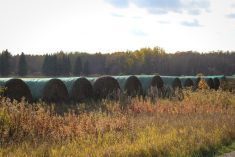CNS Canada — Excessive moisture in some parts of Manitoba over the past few months has led to localized forage shortages heading into the winter. However, ample feed grain supplies are expected to help supplement any lack of forages.
Manitoba’s Interlake region was particularly hard hit by moisture in 2014. Water levels on both Lake Winnipeg and Lake Manitoba were very high, which limited the amount of native hay that was cut, said Tim Clarke, an Interlake-based forage and pasture specialist with Manitoba Agriculture, Food and Rural Development.
Read Also

USDA confirms bird flu case in Wisconsin dairy herd as new wildlife spillover
The United States Department of Agriculture on Friday confirmed that a case of highly pathogenic avian influenza in a Wisconsin dairy herd marked a new spillover event from wildlife to cattle, separate from previous outbreaks.
“Guys are quite short of forage supplies around the lakes,” said Clarke. The southwestern corner of the province was also short due to excess moisture and flooding, he added.
The provincial government runs a hay listing service, and Clarke pointed out there is no hay now listed for sale in the northern Interlake and less than a handful in the southwest. By comparison, there were over 20 listings in the eastern part of the province as of Tuesday.
Quality of some of the hay that was cut is also a bit lower than normal, as rains delayed the cut in June and July, which led to a higher fibre content. “Digestibility goes down when fiber goes up,” said Clarke.
While importing hay or moving cattle closer to forage are both options, Clarke recommended anyone with low forage supplies should take advantage of the abundance of cheap feed grain this year.
The large U.S. corn crop is weighing on corn prices in general, while much of the Manitoba corn crop is also coming off tough and damp, he said.
Tough and damp corn was priced at about $160 per tonne, while dried distillers grains (DDGS) could be bought for under $170 per tonne from Husky Energy’s ethanol plant at Minnedosa, Man.
When supplementing grain — especially feed wheat — in the place of forages, farmers should make sure to watch for fusarium and ergot, said Clarke.
A higher-grain diet leads to a change in how the cattle are fed. “The logistics are a little different when you start feeding cows grain, because they’ll run you over to get to the trough,” he said.
The animals’ nutritional needs may be met, but the cattle won’t feel as full with a high grain diet, he said, noting eight pounds of grain could be substituted in the place of about 25 pounds of hay.
— Phil Franz-Warkentin writes for Commodity News Service Canada, a Winnipeg company specializing in grain and commodity market reporting.















